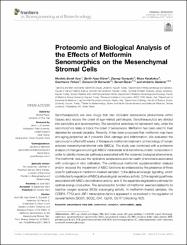| dc.contributor.author | Acar, Mustafa Burak | |
| dc.contributor.author | Ayaz-Guner, Serife | |
| dc.contributor.author | Gunaydin, Zeynep | |
| dc.contributor.author | Karakukcu, Musa | |
| dc.contributor.author | Peluso, Gianfranco | |
| dc.contributor.author | Di Bernardo, Giovanni | |
| dc.contributor.author | Ozcan, Servet | |
| dc.contributor.author | Galderisi, Umberto | |
| dc.date.accessioned | 2022-03-05T08:30:16Z | |
| dc.date.available | 2022-03-05T08:30:16Z | |
| dc.date.issued | 2021 | en_US |
| dc.identifier.issn | 2296-4185 | |
| dc.identifier.other | PubMed ID34676202 | |
| dc.identifier.uri | https //doi.org/10.3389/fbioe.2021.730813 | |
| dc.identifier.uri | https://hdl.handle.net/20.500.12573/1236 | |
| dc.description | This work was supported by The Scientific and Technological Research Council of Turkey (TUBITAK) (Project Number: 117S216) to S.O. | en_US |
| dc.description.abstract | Senotherapeutics are new drugs that can modulate senescence phenomena within tissues and reduce the onset of age-related pathologies. Senotherapeutics are divided into senolytics and senomorphics. The senolytics selectively kill senescent cells, while the senomorphics delay or block the onset of senescence. Metformin has been used to treat diabetes for several decades. Recently, it has been proposed that metformin may have anti-aging properties as it prevents DNA damage and inflammation. We evaluated the senomorphic effect of 6 weeks of therapeutic metformin treatment on the biology of human adipose mesenchymal stromal cells (MSCs). The study was combined with a proteome analysis of changes occurring in MSCs' intracellular and secretome protein composition in order to identify molecular pathways associated with the observed biological phenomena. The metformin reduced the replicative senescence and cell death phenomena associated with prolonged in vitro cultivation. The continuous metformin supplementation delayed and/or reduced the impairment of MSC functions as evidenced by the presence of three specific pathways in metformin-treated samples: 1) the alpha-adrenergic signaling, which contributes to regulation of MSCs physiological secretory activity, 2) the signaling pathway associated with MSCs detoxification activity, and 3) the aspartate degradation pathway for optimal energy production. The senomorphic function of metformin seemed related to its reactive oxygen species (ROS) scavenging activity. In metformin-treated samples, the CEBPA, TP53 and USF1 transcription factors appeared to be involved in the regulation of several factors (SOD1, SOD2, CAT, GLRX, GSTP1) blocking ROS. | en_US |
| dc.description.sponsorship | Turkiye Bilimsel ve Teknolojik Arastirma Kurumu (TUBITAK) 117S216 | en_US |
| dc.language.iso | eng | en_US |
| dc.publisher | FRONTIERS MEDIA SAAVENUE DU TRIBUNAL FEDERAL 34, LAUSANNE CH-1015, SWITZERLAND | en_US |
| dc.relation.isversionof | 10.3389/fbioe.2021.730813 | en_US |
| dc.rights | info:eu-repo/semantics/openAccess | en_US |
| dc.subject | mesenchymal stem cells | en_US |
| dc.subject | senescence | en_US |
| dc.subject | senolytics | en_US |
| dc.subject | senomorphics | en_US |
| dc.subject | aging | en_US |
| dc.title | Proteomic and Biological Analysis of the Effects of Metformin Senomorphics on the Mesenchymal Stromal Cells | en_US |
| dc.type | article | en_US |
| dc.contributor.department | AGÜ, Yaşam ve Doğa Bilimleri Fakültesi, Moleküler Biyoloji ve Genetik Bölümü | en_US |
| dc.contributor.authorID | 0000-0002-1052-0961 | en_US |
| dc.contributor.institutionauthor | Ayaz-Guner, Serife | |
| dc.identifier.volume | Volume 9 | en_US |
| dc.relation.journal | FRONTIERS IN BIOENGINEERING AND BIOTECHNOLOGY | en_US |
| dc.relation.tubitak | 117S216 | |
| dc.relation.publicationcategory | Makale - Uluslararası - Editör Denetimli Dergi | en_US |


















